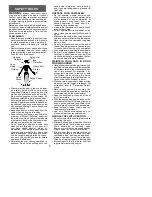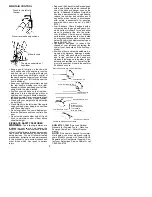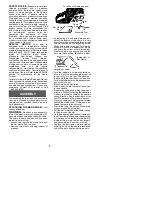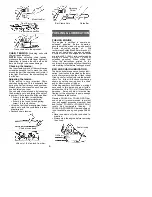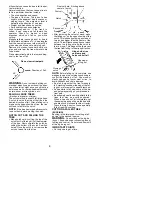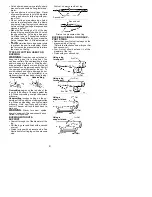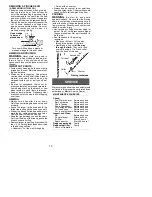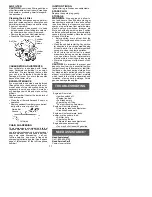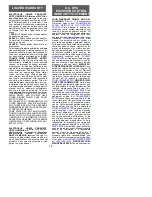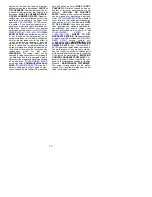
8
ditions that can cause the tree to fall in a par-
ticular direction.
Natural conditions that can cause a tree to
fall in a particular direction include:
S
The wind direction and speed.
S
The lean of the tree. The lean of a tree
might not be apparent due to uneven or
sloping terrain. Use a plumb or level to
determine the direction of tree lean.
S
Weight and branches on one side.
S
Surrounding trees and obstacles.
Look for decay and rot.
If the trunk is
rotted, it can snap and fall toward the
operator. Check for broken or dead
branches which can fall on you while
cutting.
Make sure there is enough room for tree to
fall. Maintain a distance of
2-1/2
tree lengths
from the nearest person or other object. En-
gine noise can drown out a warning call.
Remove dirt, stones, loose bark, nails, sta-
ples, and wire from the tree where cuts are
to be made.
Plan a clear retreat path to the rear and diag-
onal to the line of fall.
Direction of Fall
45
_
Plan a clear retreat path
WARNING
:
Do not cut near buildings or
electrical wires if you do not know the direc-
tion of tree fall, at night since you will not be
able to see well, or during bad weather such
as rain, snow, or strong winds. etc.
FELLING LARGE TREES
(6 inches in diameter or larger)
The notch method is used to fell large trees.
A notch is cut on the side of the tree in the
desired direction of fall. After a felling cut is
made on the opposite side of tree, the tree
will tend to fall into the notch.
NOTE:
If the tree has large buttress roots,
remove them before making the notch.
NOTCH CUT AND FELLING THE
TREE
S
Make notch cut by cutting the top of the
notch first. Cut through
1/3
of the diameter
of the tree. Next complete the notch by
cutting the bottom of the notch. See illus-
trated. Once the notch is cut remove the
notch of wood from the tree.
Notch
First cut
Second cut
Final cut here. 2 inches above
center of notch.
S
After removing the cutout of wood, make
the felling cut on the opposite side of the
notch. This is done by making a cut about
two inches higher than the center of the
notch. This will leave enough uncut wood
between the felling cut and the notch to
form a hinge. This hinge will help prevent
the tree from falling in the wrong direction.
Opening of
felling cut
Closing of
notch
Hinge holds tree
on stump and
helps control fall
NOTE:
Before felling cut is complete, use
wedges to open the cut when necessary to
control the direction of fall. Use wood or
plastic wedges, but never steel or iron, to
avoid kickback and chain damage.
S
Be alert to signs that the tree is ready to
fall: cracking sounds, widening of the fell-
ing cut, or movement in upper branches.
S
As tree starts to fall, stop saw, put it down,
and get away quickly on your planned re-
treat path.
S
Be extremely cautious with partially fallen
trees that may be poorly supported.
When a tree doesn’t fall completely, set
the saw aside and pull down the tree with
a cable winch, block and tackle, or tractor.
To avoid injury, do not cut down a partially
fallen tree with your saw.
CUTTING A FALLEN TREE
(BUCKING)
Bucking is the term used for cutting a fall-
en tree to the desired log size.
WARNING
:
Do not stand on the log be-
ing cut. Any portion can roll causing loss of
footing and control. Do not stand downhill
of the log being cut.
IMPORTANT POINTS
S
Cut only one log at a time.


